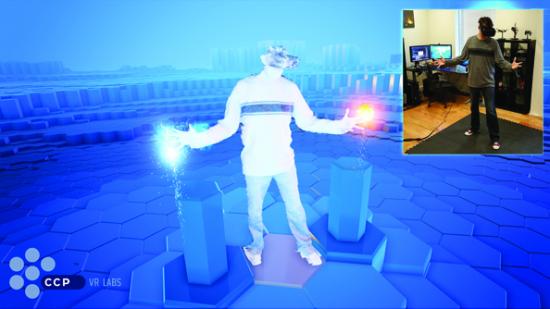Adam Kraver had his first vision of what virtual reality was going to be when he was 16 – sitting in his living room, playing Dungeon Master with friends on the Amiga.
“I can still see what I saw in my head at that time,” he said. “Someone holding their hand up in front of them, doing a motion, the fire lighting – and they’re in a dungeon corridor. They look over, and there are their friends behind ‘em.”
The vision has dogged Kraver throughout his career – so insistently that, when he was working on World of Darkness, he would go home to a self-built “VR cave”: a sheet of plastic with a projector behind it, and a Kinect sitting beneath.
Now, Kraver’s job title is Architect. He and a handful of World of Darkness refugees are following in the footsteps of the Eve: Valkyrie team – introducing fans and manufacturers to their experimental full-body VR project at Fanfest.
“I feel like my entire career has been building to this point,” said Kraver.
Remember Palmer Luckey’s first-ever public Oculus Rift prototype? The one with the duct tape? The VR kit CCP Atlanta have pieced together is a bit like that. Consisting of a hacked Kinect, a blank square of floor and a headset wired to the ceiling, it could be diplomatically described as homebrew. But that’s only fitting, since it was first conceived at home by Kraver.
Work began on the project three and a half years ago – not for CCP, but in the spare time afforded by Kraver’s work at a motion capture studio. Kraver had specialised in computer vision, and when the Kinect came out, was blown away by what he thought to be the “ultimate computer visioning device”. Until he saw the games being made for it.
Frustrated, Kraver started poking at the problem of a motion-captured player avatar. He experimented with moving through an environment, knocking over boxes, holding a sword and shield. “How do I get myself in there?”, he asked.
A conventional television screen didn’t offer enough real estate, and so Kraver took to Craigslist for extra equipment – building the “poor man’s VR cave” in his basement and wearing red-blue 3D glasses for the stereo effect.
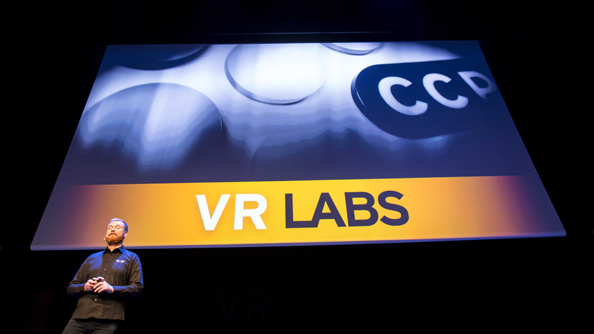
Image courtesy ofBrynjar Snaer
“I could stand in front of it and get a perspective-correct view,” he said. “Rather than looking at a screen on a TV, I was looking through this window into another world.”
This was pre-Oculus – the uncommercial tinkering of a lone hobbyist. When the Rift DK1 arrived, Kraver’s basement attempts to project a ball onto his hand were suddenly validated – but he remained convinced that the future lay beyond Xbox controllers in full-body simulation.
“I knew almost immediately that one of the big problems with VR is that you’re blinding yourself to the world,” he said. “I also knew that I didn’t want experiences where I just sat there and drove a head around through space. Because that’s not really compelling.”
There’s a rule in the Kraver household for when they play Rock Band: rock stars don’t sit down.
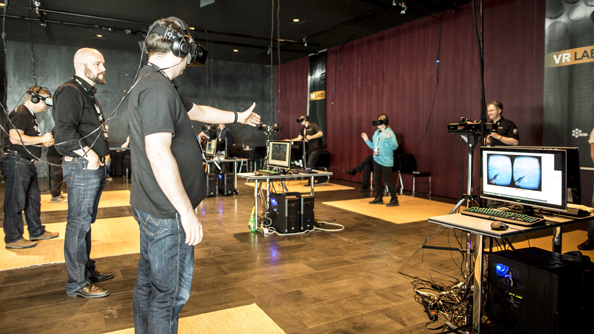
Image courtesy ofBrynjar Snaer
“I found very early on with Rock Band that there were two modes by brain would go in,” he explained. “I would sit on the couch and play a Rock Band game. Or I’d stand up in front of the big projector, and I’d be a rock god.”
The Rift DK2 shipped, and Kinect 2 followed soon after – finally offering enough fidelity to render human hands (“They look wonky and they look weird, but it’s you”). Kraver was beginning, too, to incorporate the real world into his simulation. He began using a depth renderer to show the outline of the environment around him – for the sake of the cats wandering in and out of his home office (“You don’t want to be kicking boxes [in VR] and nail one of your beloved pets”).
After playing with scale options, Kraver soon had cats the size of horses strutting about his room: as strong a pitch as any for the entertainment medium of the future.
On occasion, he would lug his “super-Frankenstein machine” into the CCP Atlanta office, where colleagues would be “blown away” but understandably sceptical. They were working on vampiric MMO World of Darkness – which at the time seemed a much more sensible investment.
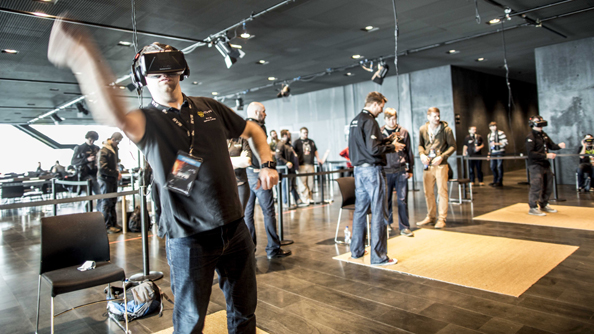
Image courtesy ofBrynjar Snaer
But then the landscape changed. Facebook bought Oculus – and, a year ago, CCP shut down World of Darkness. Most of the Atlanta team were laid off – but a handful stayed behind to experiment with VR. Frankenstein’s monster was moved into the office.
Kraver’s vision is no longer a pipedream. His team have watched Eve: Valkyrie’s trajectory from side project to “real thing” – “and not only that, but [becoming] a cornerstone of the first round of VR games. And it’s very clear that VR is going to be a very, very big thing.”
Several Atlantan prototypes were on show at Fanfest, including a Tron-inspired disc-hurling game in which two players, tracked by two different cameras, faced off competitively. A ‘ship spinner’ allowed users to turn and examine large and intricate Eve vessels with their hands, before pushing their heads through the armour to inspect the bridge and engines inside. A hexagonal map of Iceland could be pressed and pushed to produce ripples.
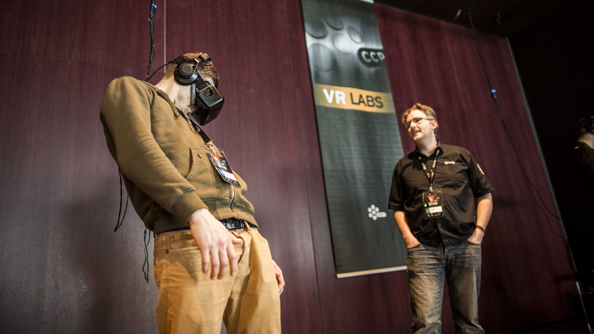
Image courtesy ofBrynjar Snaer
Some of Kraver’s earliest ideas have made appearances – scaling players up to ginormous size, enabling them to hurl fireballs, and tracking their limbs as they kick at physics-enabled boxes. All are navigated using a point-and-swipe interface that works a lot like the Kinect’s, but in three dimensions.
Though it was a whirlwind demonstration of totally unfamiliar tech, the Atlantan setup felt surprisingly intuitive and natural. Playing other VR games, you’re suddenly closed off from the world. Don the goggles in CCP’s new demo, by contrast, and the first thing you’re asked to do is take a step forward.
It’s hard to go back. Sat in Valkyrie’s cutting-edge cockpit later, I looked down and an involuntary thought popped into my head: those aren’t my legs.
“We believe in the immediacy of no controller – the social aspect of having your body there,” said Kraver. “That this is a critical feature for VR to hit that absolute crushing mass market.”
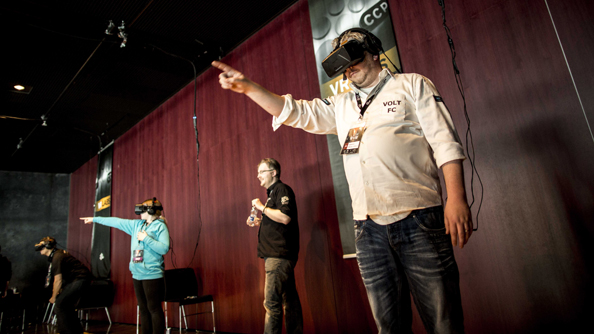
Image courtesy ofBrynjar Snaer
There’s another way full-body simulation breaks down the approachability barriers to VR: at the time of our interview, Fanfest attendees had yet to report even a single instance of simulation sickness. There’s a suggestion that body-tracked players might be happy to wear their goggles for longer, opening VR up to whole new laid-back genres and design possibilities.
“I think a lot of people are struggling with the idea of how we can do a first-person shooter in VR. And my view is – don’t even bother,” said Kraver. “Because I can give you a much better experience in a 6×6 area with lots to explore and interact with.”
The tech is still a long way from commercial release. The Fanfest demo is partly about the search for a partner willing to manufacture this strange assembly of hardware. Even Valve’s GDC Holodeck doesn’t quite fit, with its two controllers in place of Kinect-style motion tracking.
“We want people to understand that this is an option and a possibility,” said Kraver. “What happens next is in the hands of product manufacturers, and ultimately what we decide to do. I want to see this in a lot of peoples’ homes.”
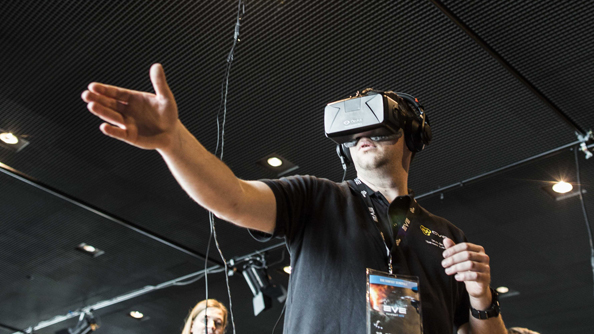
Image courtesy ofBrynjar Snaer
But Kraver’s escapist vision has already been made real – in a different sort of fantasy dungeon. Working with the Unreal Engine, CCP Atlanta have tried out their tech using the striking UE4 tech demo that takes place in a spacious Parisian flat.
The Architect recalls lining up his office chair to match the position of a virtual seat in the gleaming-white apartment, and sitting down. He watched the skyline for a while. It was peaceful. And then he took off his goggles, and the noise of the office flooded in. It was a powerful moment.
“If someone lives in a bad apartment in a bad neighbourhood, they can be someplace special that they’ve constructed themselves,” realised Kraver. “And it can be anything, anywhere.
“What it’ll do for people who don’t have the lives that they want, and can’t get the lives that they want, [is allow them to] create the lives they want and share them with their family and everything else.”
